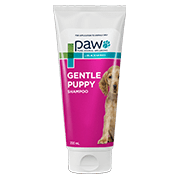
- A Guide To Perfect Your Pet's Health/
- Health and Vitality Products For Your Dog/
- Everything You Need For a New Puppy


Just like a young child, your puppy is seeing and experiencing the world for the first time. It’s inquisitive and still learning, and this will likely mean it’s into everything around your home, whether a tangle of computer cords or your shoes by the door.
Also like a young child, your puppy needs you to supply a few life essentials, whether for health and grooming, or comfort and training.
Puppy purchase checklist
Home
- Dog bed and blanket: For comfort when napping
- Puppy pee pads: To assist with house training
- Toys: For both chewing and play
- Baby gate: To block off areas of the house, like stairs
- Doggy pheromone spray: The odour helps your new puppy relax and feel safe
- Kennel/crate: For sleep training
- Odour neutraliser: To nix odours resulting from accidents
Health
- Puppy shampoo and conditioner: Try gentle shampoo and conditioning spray while young skin is sensitive
- Brush: Because good grooming is important from an early age
- Nail clippers: To get them used to having their nails clipped early
- Flea, tick and worming tablets: An essential part of any health regimen
- Toothbrush and paste: Start brushing early for best acceptance!
Exercise
- Collar and ID tag: For easy identification
- Leash and/or harness: When it comes time to take a walk
- Poo bags: To pick up after your pooch
- Doggy waterbottle: To refuel after park play
- Car harness: For safe commutes
Food
- Puppy-specific food: To ensure they receive essential nutrients
- Treats: For positive reinforcement
- Water and food bowls: Separate, so water is available at all times
Essentials
- Appointment at vet for vaccines and microchipping: To keep your pet healthy and identifiable
- Council registration: For pet identification (once microchipped)
- Pet insurance: So you’re covered if an accident happens
- Registration for puppy school: To establish good habits and socialise your pooch
How can I puppy proof my home?
In addition to making your pet comfortable when they join your family, you should consider addressing some indoor and outdoor hazards around your home, prior to their arrival. They include:
Indoors
- Rubbish bins: Make sure they’re out of reach of your pet, or are sturdy enough not to be knocked over intentionally or during play.
- Water features: Indoor fountains, low bathtubs, buckets of water – these are drowning hazards for your puppy.
- Cords: Electrical cords are fun to chew, but split wires are not only frustrating for you, they could give your pooch a shock. Bundle cords with spiral cable wrap or in a PVC tube.
- Fire: Screen off your fireplace, and create a boundary around wood-burning stoves. These are cosy places to lie, but your puppy doesn’t know how close they can get.
- Toys and small objects: Lego, buttons, pins, socks, dental floss – puppies will try to eat anything they can, and these objects could cause serious intestinal damage.
Outdoors
- Fences/gates: Essential to keep your puppy in your yard and safe.
- Garage: From paint and rat poison to lawn mowers and tools, garages house a lot of danger. Make sure there’s a secure door on your garage, and that containers and equipment are out of reach.
- Water: For the same reason as above, ensure that any outdoor water features and pools are securely gated
- Fire: As with your fireplace, fence off your outdoor barbeque or fire pit.
- Others: Check for broken glass, exposed nails or potentially toxic plants (see below).
What common household items are dangerous for dogs?
Surprisingly, a lot of things you take for granted around the house can be dangerous for your puppy. A number of indoor and outdoor plants can hurt (think, falling on a ground cactus) or be toxic, including lilies, azaleas, philodendrons, ivy, lantana and aloe vera. If you must keep these indoors, make sure they’re well out of the reach of your pooch. Pick different species to grow outside, or else do some careful fencing, as most flora is at ground level and easy for your pet to access.Cleaning products are also a hazard, and while most of us keep them under the sink, it’s a good idea to put them on a shelf out of reach or in a cupboard you can lock. It’s the same for human medications – be careful not to leave packages lying around, as puppies are remarkably good at getting into fun-looking boxes.
Finally, human foods. While you might think you’re treating your puppy by giving them scraps from your plate, many human foods (grapes, chocolate, macadamias, etc) are harmful to dogs, and can cause illness or lead to long-term health issues like obesity.
Where should my puppy sleep at night?
Puppies have a lot of energy, and all that time playing needs to be matched with rest – in fact, most sleep between 18 and 20 hours a day. The first few weeks you have your new pooch, however, their sleep cycle may not be in sync with yours, and you’ll likely find yourself being awakened during the night.
You may want to have your new pooch snuggle up in bed next to you, but chances are this will be distracting for you both. While your puppy is young and still being trained, it’s a good idea to have them sleep in a crate. Make sure their space is in a quiet corner close to you and is as cosy as possible, with blankets and comforting, familiar toys.
Help develop an evening routine by taking them for a walk just before bed to burn off any remaining energy and so they can use the loo. When it’s time to sleep, darken the room to signify that it’s now time to be calm and rest – some vets suggest playing classical music as they prepare to snooze. As they become comfortable with this arrangement and are sleeping through the night, you can try moving them to their own bed or onto yours, if you choose.
How long does it take to house-train a puppy?
It can take your puppy six months to be fully house-trained – or even longer, depending on breed and size. The training process relies on three things: consistency, positive reinforcement and patience.
Consistency:
Consistency: Establish regular intervals to take your puppy outside to the toilet, particularly at key times like after a nap, after eating, after play and before bedtime. Have a set destination, so that they associate that with loo time. Keep in mind that smaller dogs have smaller bladders and fast metabolisms, so may require more outdoor breaks than larger puppies.
In addition, pick an area for your pet to go to the toilet in emergencies, whether on your balcony or in the bathroom. This is where your pee pad goes, and where you swoop your pooch when you notice urgent signs your pup needs to go, like circling, sniffing or whining.
Positive reinforcement:
Have treats handy to show your pup they’re doing a great job when they make it outside or onto their pee pad without your assistance. They’re more likely to repeat the behaviour if they’re getting rewarded for their efforts.
Patience:
Your pup can’t pee on demand, and will likely have accidents for the first few months. It’s important to be patient, as your efforts will pay off in the long run.



